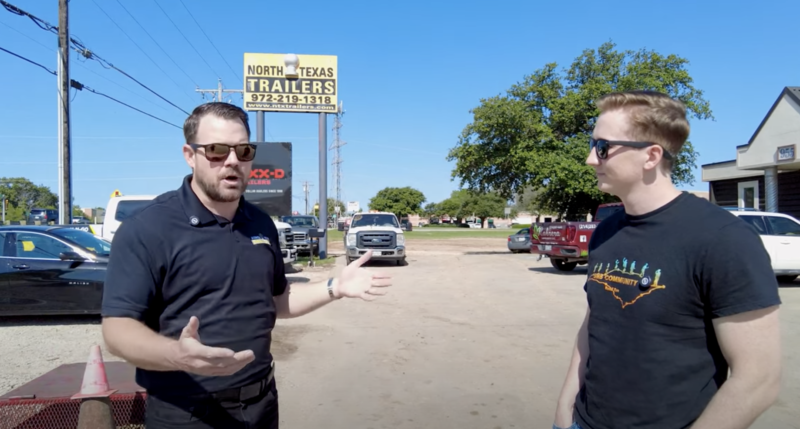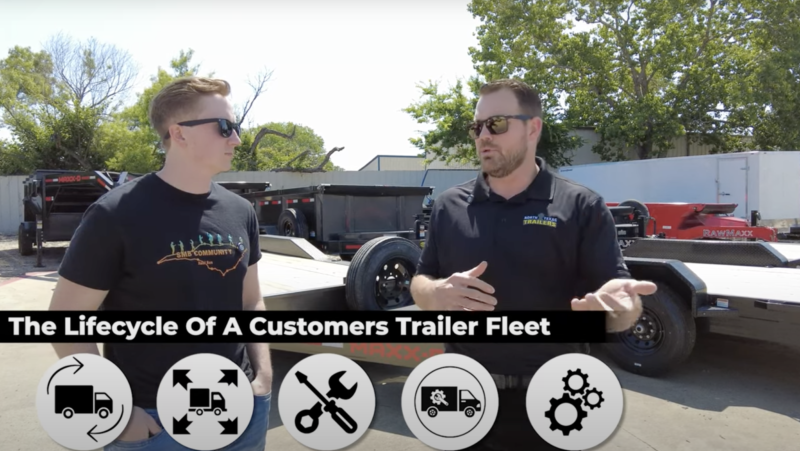I recently spent time with Shane, known as “The Texas Trailer King,” who has grown his trailer dealership to an impressive $10.5 million in annual revenue.
I’ve broken down the most valuable tactics he shared with me, from revenue mix to fleet focus, inventory management, multiple locations, service and repairs, and more.
If you’re in the trailer business or thinking about getting in, this is the stuff you need to know.
Table of Contents
Video Gallery
1. Revenue Mix
Here’s the first thing I learned walking through Shane’s operation – you can’t put all your eggs in one basket. The real money comes from multiple streams:
Shane’s average trailer is $9,000, and yes, that’s great. But what keeps him stable? It’s having his hands in everything.
- Steady service revenue stream from repairs and maintenance.
- Parts department providing consistent cash flow.
- Service any brand trailer, not just the brands they sell.
When trailer sales slow down (and they will), Shane can use other revenue streams to keep the lights on and continue to provide stability during market fluctuations.
2. Fleet Focus
Shane is a big fan of fleet customers, they’re absolute game-changers. He specifically goes after businesses that run multiple trailers.
- Focus on businesses operating 5+ trailers.
- Implement a dedicated sales role for fleet acquisition.
- Prioritize multi-trailer purchase opportunities.
- Develop recurring service relationships with fleet operators.
- Create comprehensive fleet maintenance programs.
Whatever they need, they will always come back. It’s like having a subscription business in the trailer world.
3. Inventory Management
This one’s crucial, and Shane learned it the hard way. Success in this business isn’t just about having inventory – it’s about having the RIGHT inventory and managing it properly:
- Utilize floor plan financing to maintain larger inventory.
- Establish relationships with multiple manufacturers.
- Maintain ready-to-sell inventory for immediate customer needs.
- Share inventory across locations to maximize selection.
- Monitor inventory turns and adjust purchasing accordingly.
You want to make sure you monitor your inventory regularly – every day a trailer sits, it costs you extra money, and unsold inventory isn’t smart.

4. Multi-Location Strategy
Shane strategically places his locations 30 minutes apart, close enough to share inventory, but far enough to avoid cannibalization.
- Establish locations within a 30-minute drive of each other.
- Implement a unified inventory management system.
- Enable selling from the total inventory pool (250 vs 100 units).
- Develop location-specific specialties.
- Share resources and expertise across locations.
This isn’t just about having multiple locations; it’s about how they work together.
When a customer walks in, they have access to everything they own, not just what’s on that lot.
5. Employee Compensation
Shane is very clear about this tactic – your compensation structure can make or break your growth.
- Structure commissions based on gross profit.
- Implement enhanced bonus structures for growth periods.
- Add corporate-style benefits to attract top talent.
- Create incentives for upselling and customer retention.
- Pool commissions for service/parts teams.
When the company wins, everyone wins – that’s not just talk, it’s in their paychecks.

6. Service Expansion
Want to know where the real opportunity is? It’s in expanding your service capabilities beyond basic trailer work.
- Offer chassis and suspension work on RVs/travel trailers.
- Develop full fabrication and customization capabilities.
- Provide comprehensive service offerings beyond basic repair.
- Train technicians in multiple specializations.
- Implement a complimentary inspection program.
Shane’s technicians are trained across multiple specialties because versatility equals profitability.
7. Strategic Partnership
Here’s something most dealers miss – strategic partnerships can double your business if you do them right.
- Establish relationships with rental companies.
- Create cross-referral programs.
- Share customer bases where beneficial.
- Secure service contracts for partner fleets.
- Leverage partner relationships for market expansion.
We partnered with rental companies – they store their trailers on our lot, and we get all their repair work and first shot at sales when they upgrade their fleet.
In this case, you’re not just a dealer anymore, you’re part of a larger ecosystem.
8. B2B Service
If you want to grow fast in this business, you need to think like a B2B company, not a retail store.
- Assign a single point of contact for each business customer.
- Implement priority service for fleet customers.
- Develop comprehensive maintenance programs.
- Focus on minimizing customer downtime.
- Create efficient communication protocols.
The whole service model is built around getting business customers back on the road as quickly as possible.
9. Market Positioning
Here’s the truth – competing on price is a race to the bottom.
- Focus on service quality over price competition.
- Provide full lifecycle support (sales, service, parts).
- Implement corporate-style benefits and operations.
- Develop a professional image distinct from basic trailer lots.
- Build a reputation for reliability and expertise.
When a business owner needs a trailer, they’re not just buying the metal – they’re buying the confidence that you’ll keep them running.
10. Inventory Optimization
Let me share something crucial about inventory – it’s not about having everything, it’s about having the right mix.
- Stock units ranging from $2,500 to $50,000+.
- Balance common and specialty trailers.
- Maintain relationships with multiple manufacturers.
- Stock based on business customer requirements.
- Monitor market trends for inventory adjustment.
Remember to constantly watch what moves and what sits, and adjust to demand.
Conclusion
These tactics can work, but they’re not a magic bullet. Every market is different, and you’ll need to adapt these strategies to your situation.
Many dealers have tried to implement everything at once and get overwhelmed. Start with what makes sense for your business right now.
Focus on building one area at a time. What I’ve learned is that the most successful dealers aren’t just selling trailers – they’re building a complete solution for their customers.
Follow me on X for more content like this.
